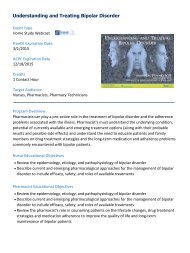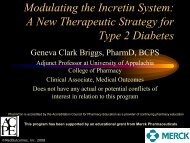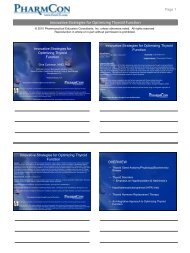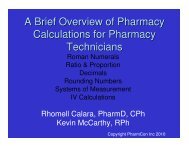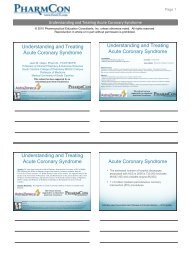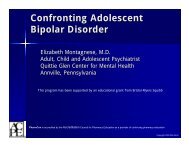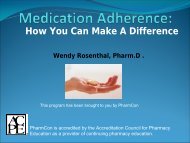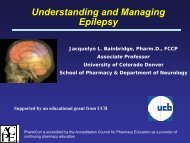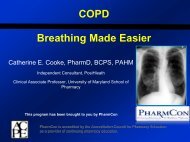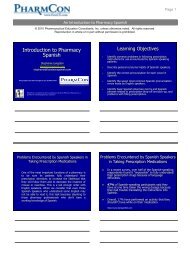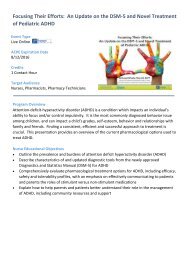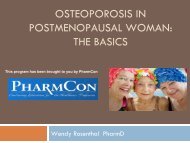Adult ADHD - Free CE Continuing Education online pharmacy ...
Adult ADHD - Free CE Continuing Education online pharmacy ...
Adult ADHD - Free CE Continuing Education online pharmacy ...
- No tags were found...
You also want an ePaper? Increase the reach of your titles
YUMPU automatically turns print PDFs into web optimized ePapers that Google loves.
Page 1<strong>Adult</strong> <strong>ADHD</strong>: Fact or Fiction?© 2010 Pharmaceutical <strong>Education</strong> Consultants, Inc. unless otherwise noted. All rights reserved.Reproduction in whole or in part without permission is prohibited.<strong>Adult</strong> <strong>ADHD</strong>: Fact or Fiction?AccreditationFacultyPharmacists: 0798-0000-12-039-L01-PPharmacy Technicians: 0798-0000-12-039-L01-TNurses: N-763Elizabeth Montagnese, MDChild and <strong>Adult</strong> PsychiatristQuittie Glen Center for Mental Health<strong>CE</strong> Credit(s)Faculty Disclosure1.0 contact hour(s)Dr. Montagnese has no actual or potential conflicts ofinterest in relation to this program.Learning Objectives•Identify key aspects and symptoms that distinguish adult <strong>ADHD</strong> from childhood <strong>ADHD</strong>•Review the diagnostic criteria and casual theories of <strong>ADHD</strong> and proposed changes to DSM-5•Review the effects of undiagnosed and untreated adult <strong>ADHD</strong>•Compare the current evidence-based treatments available for the disorder, both pharmacologic and non-pharmacologic•Compare available medications including dosages, metabolism, side-effect profile and reasons practitioners select specificmedications for individual patientsElizabeth Montagnese, MDChild and <strong>Adult</strong> PsychiatristQuittie Glen Center for Mental HealthAnnville, PennsylvaniaLegal DisclaimerThe material presented here does not necessarily reflect the views of Pharmaceutical <strong>Education</strong> Consultants (PharmCon) or the companies thatsupport educational programming. A qualified healthcare professional should always be consulted before using any therapeutic product discussed.Participants should verify all information and data before treating patients or employing any therapies described in this educational activity.PharmCon is accredited by the Accreditation Council for Pharmacy <strong>Education</strong> as a provider of continuing <strong>pharmacy</strong> educationLearning Objectives• Identify key aspects and symptoms that distinguish adult<strong>ADHD</strong> from childhood <strong>ADHD</strong>• Review the diagnostic criteria and causal theories of <strong>ADHD</strong>and proposed changes to DSM-5• Review the effects of undiagnosed and untreated adult<strong>ADHD</strong>• Compare the current evidence-based treatments availablefor the disorder, both pharmacologic and nonpharmacologic• An in-depth comparison of the available medications willbe presented and will include dosages, metabolism, sideeffectprofile, and reasons practitioners select specificmedications for individual patients<strong>Adult</strong> <strong>ADHD</strong>: A New Disorder?• Until the late 1960’s, <strong>ADHD</strong> was considered achildhood-only disorder• Studies in the 70’s and 80’s pointed to residualsymptoms in 30-60% of individuals• Recent studies-even higher, 65-75%• Under-diagnosed• Under-treatedPharmCon is accredited by the Accreditation Council for Pharmacy <strong>Education</strong> as a provider of continuing <strong>pharmacy</strong> educationPharmCon is accredited by the Accreditation Council for Pharmacy <strong>Education</strong> as a provider of continuing <strong>pharmacy</strong> education
Page 2<strong>Adult</strong> <strong>ADHD</strong>: Fact or Fiction?© 2010 Pharmaceutical <strong>Education</strong> Consultants, Inc. unless otherwise noted. All rights reserved.Reproduction in whole or in part without permission is prohibited.Diagnosis Over DecadesCost of <strong>ADHD</strong>• Minimal Brain Dysfunction• Hyperkinetic Disorder of Childhood• Attention Deficit Disorder• Attention Deficit Hyperactivity Disorder• $32-52 billion annually in U.S. (CDC, <strong>ADHD</strong> homepage)• Diagnosis rates have increased 3%/year from1997-2006• 56% of those with diagnosis receive meds• ~10% of adults with <strong>ADHD</strong> get treatmentPharmCon is accredited by the Accreditation Council for Pharmacy <strong>Education</strong> as a provider of continuing <strong>pharmacy</strong> educationPharmCon is accredited by the Accreditation Council for Pharmacy <strong>Education</strong> as a provider of continuing <strong>pharmacy</strong> educationEpidemiology of <strong>ADHD</strong> in Children• ~20% of children and adolescents have amental health diagnosis• <strong>ADHD</strong> is by far, the most common (3-8%)• 75% are treated by the PCP• Half of all pediatric office visits are forbehavioral, psychosocial, or academicconcernsPrim Care Corp JClin Psych 2008: 10(3): 211-221Epidemiology of <strong>ADHD</strong>• Across all cultures when same diagnostic criteriaapplied• M:F is 3-4:1• Highly heritable• 70-80% concordance in MZ twins• 30-40% of fraternal twins• 25% have a sibling• Parent with <strong>ADHD</strong>: 50% will have a child with <strong>ADHD</strong>• Females (child/adolescent): more likely to haveinattentive type, less likely to get dx and txPharmCon is accredited by the Accreditation Council for Pharmacy <strong>Education</strong> as a provider of continuing <strong>pharmacy</strong> educationPharmCon is accredited by the Accreditation Council for Pharmacy <strong>Education</strong> as a provider of continuing <strong>pharmacy</strong> education
Page 3<strong>Adult</strong> <strong>ADHD</strong>: Fact or Fiction?© 2010 Pharmaceutical <strong>Education</strong> Consultants, Inc. unless otherwise noted. All rights reserved.Reproduction in whole or in part without permission is prohibited.Epidemiology of <strong>ADHD</strong> in <strong>Adult</strong>s• Prevalence rate in adults is 4.4-5%• Not a U.S. phenomenon-studies in Europe andAustralia replicate these rates• M:F is closer to 3:2• <strong>Adult</strong>s have similar expression of disordermale to femaleCurrent DSM-IV Criteria• Present in multiple settings• Prior to age 7• Must cause significant impairment• Must be present for 6 months• Not better explained by PDD, psychotic d/o,mood/anxiety disorders, dissociative disorder,or personality disorderPharmCon is accredited by the Accreditation Council for Pharmacy <strong>Education</strong> as a provider of continuing <strong>pharmacy</strong> educationPharmCon is accredited by the Accreditation Council for Pharmacy <strong>Education</strong> as a provider of continuing <strong>pharmacy</strong> educationDSM-IV <strong>ADHD</strong> Diagnostic CriteriaDiagnosis in ChildrenEither (1) inattention(6 or more for > 6 months)• Inattention to detail/carelessmistakes• Difficulty with sustained attentionto tasks or play• Doesn’t listen• Doesn’t follow through with tasks• Disorganized• Avoids tasks requiring sustainedeffort• Loses things necessary for tasks• Easily distracted by extraneousstimuli• Forgetful in daily activitiesOr (2) hyperactivity-impulsivity(6 or more for > 6 months)• Fidgets, squirms• Leaves seat inappropriately inclassroom• Runs around or climbs excessively• Doesn’t play quietly whenexpected• “on the go” as if “driven by amotor”• Talks excessively• Blurts out answers inappropriately• Difficulty with awaiting turn• Interrupts or intrudes on others• No single test, no imaging study to confirm diagnosis• Clinical diagnosis• Synthesis of info from multiple sources: parents,teachers, caregivers• Structured interviews-in depth• Rating scales: Conners, <strong>ADHD</strong> Rating Scale IV, CBCL:become familiar with one brief, standardized checklist• Observation and interview of child• Psychoeducational testing is helpfulPharmCon is accredited by the Accreditation Council for Pharmacy <strong>Education</strong> as a provider of continuing <strong>pharmacy</strong> educationPharmCon is accredited by the Accreditation Council for Pharmacy <strong>Education</strong> as a provider of continuing <strong>pharmacy</strong> education
Page 4<strong>Adult</strong> <strong>ADHD</strong>: Fact or Fiction?© 2010 Pharmaceutical <strong>Education</strong> Consultants, Inc. unless otherwise noted. All rights reserved.Reproduction in whole or in part without permission is prohibited.<strong>Adult</strong> Criteria Needed• Increased diagnostic accuracy• Using child criteria results in missing diagnosisin many significantly affected adults• Large crossover with other disorders can makediagnosis difficult• Getting collateral information is more difficult• <strong>Adult</strong> recall of childhood symptoms is difficultMaking the Diagnosis in <strong>Adult</strong>s• Need to ask the right questions• DSM-IV criteria are more child-related• Symptoms prior to age 7 criteria was random• Get comfortable with a good screening ratingscale• Screen for it at every initial mental healthassessment, especially with certain comorbidconditionsPharmCon is accredited by the Accreditation Council for Pharmacy <strong>Education</strong> as a provider of continuing <strong>pharmacy</strong> educationPharmCon is accredited by the Accreditation Council for Pharmacy <strong>Education</strong> as a provider of continuing <strong>pharmacy</strong> education<strong>Adult</strong> Rating Scales• <strong>Adult</strong> <strong>ADHD</strong> Self Report Scale• Conners <strong>Adult</strong> <strong>ADHD</strong> Rating Scale• Barkley System of Diagnostic Scales• Brown Attention-Deficit Disorder ScalesNew Criteria Proposed for DSM-5• Due out May 2013• Adolescents older than 17 and adults-only 4criteria needed each for inattentive symptomsand hyperactive/impulsive symptoms• Age of onset increased to 12 years instead of 7– will catch individuals with later onsetimpairmentPharmCon is accredited by the Accreditation Council for Pharmacy <strong>Education</strong> as a provider of continuing <strong>pharmacy</strong> educationPharmCon is accredited by the Accreditation Council for Pharmacy <strong>Education</strong> as a provider of continuing <strong>pharmacy</strong> education
Page 5<strong>Adult</strong> <strong>ADHD</strong>: Fact or Fiction?© 2010 Pharmaceutical <strong>Education</strong> Consultants, Inc. unless otherwise noted. All rights reserved.Reproduction in whole or in part without permission is prohibited.Once An Asset, Now A Deficit• Was there some early advantage to <strong>ADHD</strong>symptoms?• Environment changed rapidly• Genes haven’t caught up (?)Modern Day Environmentfor Children and <strong>Adult</strong>s• School/workplace demands• Attentional focus• Motor passivity• Many distractions-<strong>ADHD</strong> brain is wired topay attention to distractions• Passive listening• Delayed responsePharmCon is accredited by the Accreditation Council for Pharmacy <strong>Education</strong> as a provider of continuing <strong>pharmacy</strong> educationPharmCon is accredited by the Accreditation Council for Pharmacy <strong>Education</strong> as a provider of continuing <strong>pharmacy</strong> educationModern Day Environment for <strong>Adult</strong>sSchool/Work and the <strong>ADHD</strong> Individual• Demands for large amounts ofinformation management• Increased intellectual demandsPharmCon is accredited by the Accreditation Council for Pharmacy <strong>Education</strong> as a provider of continuing <strong>pharmacy</strong> educationPharmCon is accredited by the Accreditation Council for Pharmacy <strong>Education</strong> as a provider of continuing <strong>pharmacy</strong> education
Page 6<strong>Adult</strong> <strong>ADHD</strong>: Fact or Fiction?© 2010 Pharmaceutical <strong>Education</strong> Consultants, Inc. unless otherwise noted. All rights reserved.Reproduction in whole or in part without permission is prohibited.Why is this important?For Children and Adolescents• Steering child toward moreadaptiveenvironments/pursuits• Changing environments tofit the child• Strengths vs weaknessesassessment• Providing treatment earlyon when brain is pliableFor <strong>Adult</strong>s• Helps adult achieve to theirpotential• Helps adults understandwhy they may be workingharder than others to getsame or worse results• Can help with career choice• Can help spouseunderstand/supportRemember: the acorn does not fall far from thetree. You might need to treat the parent(s) too!PharmCon is accredited by the Accreditation Council for Pharmacy <strong>Education</strong> as a provider of continuing <strong>pharmacy</strong> educationPharmCon is accredited by the Accreditation Council for Pharmacy <strong>Education</strong> as a provider of continuing <strong>pharmacy</strong> educationFamilial <strong>ADHD</strong><strong>ADHD</strong> Parent with an <strong>ADHD</strong> Childmuchmore complex situation• Problems are multi-generational• The spouse can be unsupportive oroverburdened or both• Think in terms of the family systemPharmCon is accredited by the Accreditation Council for Pharmacy <strong>Education</strong> as a provider of continuing <strong>pharmacy</strong> educationPharmCon is accredited by the Accreditation Council for Pharmacy <strong>Education</strong> as a provider of continuing <strong>pharmacy</strong> education
Page 7<strong>Adult</strong> <strong>ADHD</strong>: Fact or Fiction?© 2010 Pharmaceutical <strong>Education</strong> Consultants, Inc. unless otherwise noted. All rights reserved.Reproduction in whole or in part without permission is prohibited.Theories of Causation• Multifactorial• Genetics• Neurotransmitter deficits:dopamine,norepinephrine• Perinatal complications• Toxins: drugs, smoking,alcohol in pregnancy, leadexposure• Trauma, neurologicaldisorders• Early severe deprivationTechnology and <strong>ADHD</strong>• "You prime the mind to accept a fast pace.Real life doesn’t happen fast enough to keepyour attention.”~Dimitri Christakis, MD, PHD, Univ of Washington• AAP-Limit tech/screen time, no TV
Page 8<strong>Adult</strong> <strong>ADHD</strong>: Fact or Fiction?© 2010 Pharmaceutical <strong>Education</strong> Consultants, Inc. unless otherwise noted. All rights reserved.Reproduction in whole or in part without permission is prohibited.Differential Diagnosis• Psychiatric• Medical• MalingeringSubstance Abuse and Stimulants• CNS stimulants are rarely abused by <strong>ADHD</strong>patients• Used properly, they decrease the likelihoodof later substance abuse in these patients• If there is comorbid substance abuse, treat itfirstPharmCon is accredited by the Accreditation Council for Pharmacy <strong>Education</strong> as a provider of continuing <strong>pharmacy</strong> educationPharmCon is accredited by the Accreditation Council for Pharmacy <strong>Education</strong> as a provider of continuing <strong>pharmacy</strong> educationSubstance Abuse and Stimulants• Vigilance• Information from patient and others• Treat substance abuse first• Document three or more months ofabstinence before treating <strong>ADHD</strong>• Treat the abstinent patient with Stratteraand/or stimulants, but stay vigilantRisks of Treating <strong>ADHD</strong> in <strong>Adult</strong>s• All medications have side effects• Stimulants have decades of researchbehind them• Active cardiovascular heart disease oruncontrolled hypertension• Active, untreated substance abuse• Current symptoms or past history ofbipolar disorder, especially mania• PsychosisPharmCon is accredited by the Accreditation Council for Pharmacy <strong>Education</strong> as a provider of continuing <strong>pharmacy</strong> educationPharmCon is accredited by the Accreditation Council for Pharmacy <strong>Education</strong> as a provider of continuing <strong>pharmacy</strong> education
Page 9<strong>Adult</strong> <strong>ADHD</strong>: Fact or Fiction?© 2010 Pharmaceutical <strong>Education</strong> Consultants, Inc. unless otherwise noted. All rights reserved.Reproduction in whole or in part without permission is prohibited.Risks of Not Treating <strong>ADHD</strong>• Increase risk of accidents• Poor school performance/drop out• Marital strife/divorce• Work issues: decreased productivity, job loss• Legal problems• Poor relationships• Poor self-concept, depressionTreatment Approaches• THERAPEUTIC ALLIAN<strong>CE</strong>!!!!• Behavior therapy• Life coaching/organizational coaching• Marital therapy/spouse support• Treat comorbid conditions• Psychotherapy• Pharmacotherapy-effective in 65-75%PharmCon is accredited by the Accreditation Council for Pharmacy <strong>Education</strong> as a provider of continuing <strong>pharmacy</strong> educationPharmCon is accredited by the Accreditation Council for Pharmacy <strong>Education</strong> as a provider of continuing <strong>pharmacy</strong> educationMedication Success• Inquire about patient’s/family’s feelings aboutusing medication• Educate about disorder and treatment options• Opportunity to ask questions• Prepare them for potential side effects• Validate fears/concernsUsing Stimulants• No need to start with immediate-releasestimulant unless very small child• Close follow-up during initial titration, andadjust dose weekly• Baseline BP, pulse rate, height and weight,then follow• No EKG unless personal or family historyof cardiac disease, especially dysrhythmiasPharmCon is accredited by the Accreditation Council for Pharmacy <strong>Education</strong> as a provider of continuing <strong>pharmacy</strong> educationPharmCon is accredited by the Accreditation Council for Pharmacy <strong>Education</strong> as a provider of continuing <strong>pharmacy</strong> education
Page 10<strong>Adult</strong> <strong>ADHD</strong>: Fact or Fiction?© 2010 Pharmaceutical <strong>Education</strong> Consultants, Inc. unless otherwise noted. All rights reserved.Reproduction in whole or in part without permission is prohibited.FDA Approved Medicationsfor <strong>Adult</strong> <strong>ADHD</strong>• AdderallXR• Concerta• FocalinXR• Strattera• VyvanseStimulants• Methylphenidate• Amphetamine• Lisdexamphetamine• Equally effective• 65-75% response ratePharmCon is accredited by the Accreditation Council for Pharmacy <strong>Education</strong> as a provider of continuing <strong>pharmacy</strong> educationPharmCon is accredited by the Accreditation Council for Pharmacy <strong>Education</strong> as a provider of continuing <strong>pharmacy</strong> educationFocalin(2.5, 5, 5, 10mg)Methylin(5, 10, 20mg,chew tabs, solution)Ritalin(5, 10, 20mg)MethylphenidatesShort acting: BID or TIDFDAMax/day20mg60mg60mgStarting Dose2.5-5 mg5mg5mgMetadate ER(10,20mg)Methylin ER(10, 20mg)Ritalin SR(20mg)Metadate CD(10, 20, 30, 40, 50, 60mg)Ritalin LA(20, 30, 40mg)MethylphenidatesIntermediate acting: QD or BIDFDA Max/day60mg60mg60mg60mg60mgStarting Dose10mg10mg10mg20mg20mgPharmCon is accredited by the Accreditation Council for Pharmacy <strong>Education</strong> as a provider of continuing <strong>pharmacy</strong> educationPharmCon is accredited by the Accreditation Council for Pharmacy <strong>Education</strong> as a provider of continuing <strong>pharmacy</strong> education
Page 11<strong>Adult</strong> <strong>ADHD</strong>: Fact or Fiction?© 2010 Pharmaceutical <strong>Education</strong> Consultants, Inc. unless otherwise noted. All rights reserved.Reproduction in whole or in part without permission is prohibited.MethylphenidatesAmphetaminesConcerta(18, 27, 36, 54mg)Daytrana Patch(10, 15, 20, 30mg)Focalin XR(5, 10, 15, 20mg)Long Acting: QDFDA Max/day Starting Dose72mg 18mg30mg 10mg30mg 5mgDexedrine(2.5, 5mg)Dextro-stat(5, 10mg)Adderall(5,7.5,10,20, 30mg)Short Acting: BID or TIDFDA Max/day Starting Dose40mg5mg/doseHalf forpreschoolersPharmCon is accredited by the Accreditation Council for Pharmacy <strong>Education</strong> as a provider of continuing <strong>pharmacy</strong> educationPharmCon is accredited by the Accreditation Council for Pharmacy <strong>Education</strong> as a provider of continuing <strong>pharmacy</strong> educationDexedrine Spansules(5, 10, 15mg)Adderall XR(5, 10, 15, 20, 25, 30mg)Lisdexam-phetamine(Vyvanse)(20, 30, 40, 50, 60, 70mg)AmphetaminesLong Acting: QDFDA Max/day Starting Dose40mg30mg70mg5-10mg10mg20-30mgDosing: How high is too high?• “The AACAP has also issued specific parameters for theuse of stimulant medications (American Academy ofChild and Adolescent Psychiatry, 2002). These dosesrepresent guidelines; with careful clinical monitoring,these doses may be exceeded in individual cases.”• “There is a linear relationship between dose andclinical response.”• “There is no evidence of a global therapeutic windowin <strong>ADHD</strong> patients. Each patient, however, has a uniquedose-response curve.”AACAP Practice Parameters for <strong>ADHD</strong>, 2007PharmCon is accredited by the Accreditation Council for Pharmacy <strong>Education</strong> as a provider of continuing <strong>pharmacy</strong> educationPharmCon is accredited by the Accreditation Council for Pharmacy <strong>Education</strong> as a provider of continuing <strong>pharmacy</strong> education
Page 12<strong>Adult</strong> <strong>ADHD</strong>: Fact or Fiction?© 2010 Pharmaceutical <strong>Education</strong> Consultants, Inc. unless otherwise noted. All rights reserved.Reproduction in whole or in part without permission is prohibited.Dosing: How high is too high?Stimulant Side Effects• Titrate stimulants until you get a positiveresponse or untoward side effect• In select cases, we go above FDArecommendedmax doses• These cases require close monitoring• Ask specific, rather thangeneral questions regardingside effects• Weight loss, decreasedappetite• Insomnia• Headache• Tics• Emotional irritability• Less common: psychosis,severe aggression• Growth retardation(debated)• Methylphenidate maycause relatively greaterside effects inpreschoolers• Stimulants may causeincreased irritability inchildren with autismspectrum disordersPharmCon is accredited by the Accreditation Council for Pharmacy <strong>Education</strong> as a provider of continuing <strong>pharmacy</strong> educationPharmCon is accredited by the Accreditation Council for Pharmacy <strong>Education</strong> as a provider of continuing <strong>pharmacy</strong> educationStimulant Use Precautions• Glaucoma• Hyperthyroidism• Hypertension• Don’t use with MAO-I• Drug and alcohol abuse- No evidence stimulantuse causes increased risk of substance abuse in teens• Known cardiac defectsNonstimulants: Atomoxetine• First non-stimulant FDA approved for <strong>ADHD</strong>• Not schedule II• Not immediately effective and not as effective asstimulants• Monitor for SI• MAY have less effect on sleep, appetite, tics• Common side effects: sedation, nausea, dizziness• Adjust dose if on a CYP2D6 inhibitor (paroxetine,fluoxetine)PharmCon is accredited by the Accreditation Council for Pharmacy <strong>Education</strong> as a provider of continuing <strong>pharmacy</strong> educationPharmCon is accredited by the Accreditation Council for Pharmacy <strong>Education</strong> as a provider of continuing <strong>pharmacy</strong> education
Page 13<strong>Adult</strong> <strong>ADHD</strong>: Fact or Fiction?© 2010 Pharmaceutical <strong>Education</strong> Consultants, Inc. unless otherwise noted. All rights reserved.Reproduction in whole or in part without permission is prohibited.Atomoxetine: Dosing for <strong>Adult</strong>sAtomoxetine Dosing Chartfor Children/AdolescentsStarting DoseTarget DoseMaximum Dose40 mg/day60-80 mg/day100 mg/dayWeight (lbs.) Start Dose Target Dose40-62 18mg 25mg63-93 25mg 40mg94-126 40mg 60mg127+ 40mg 80mgMaximum recommended total daily dose is1.4 mg/kg or 100mg-whichever is lessPharmCon is accredited by the Accreditation Council for Pharmacy <strong>Education</strong> as a provider of continuing <strong>pharmacy</strong> educationPharmCon is accredited by the Accreditation Council for Pharmacy <strong>Education</strong> as a provider of continuing <strong>pharmacy</strong> educationSpecial Considerations with Atomoxetine• Adolescents and adults need 24 hourcoverage• When switching from stimulant toatomoxetine, overlap stimulant use forfirst week of atomoxetine administration• Increase dose weekly until effective orside effects• Use if anxiety or D&A issues are present• Use if can’t tolerate stimulant2 nd Line Medications• Buproprion-use with comorbid depression• Tricyclic antidepressants: blood levels, ECGs• Alpha agonists: help with tics, hyperactivity,and impulsivity most• Use care in combining these with stimulants• Modafinil used occasionallyPharmCon is accredited by the Accreditation Council for Pharmacy <strong>Education</strong> as a provider of continuing <strong>pharmacy</strong> educationPharmCon is accredited by the Accreditation Council for Pharmacy <strong>Education</strong> as a provider of continuing <strong>pharmacy</strong> education
Page 14<strong>Adult</strong> <strong>ADHD</strong>: Fact or Fiction?© 2010 Pharmaceutical <strong>Education</strong> Consultants, Inc. unless otherwise noted. All rights reserved.Reproduction in whole or in part without permission is prohibited.Side Effects of Alpha AgonistsClonidine and Guanfacine• Headache• Nausea• Dizziness• Decreased heart rate• Decreased blood pressure• Sedation/somnolence• Fainting• Must taperExtended Release Alpha AgonistsIntuniv (guanfacine)FDA Max/dayStarting Dose1 – 4mg tabs 0.2mg/kg/day 0.005mg-0.08mg/kg/dayStart with 1 mg/day.Increase weekly by 1mg/day until reach 4mg/day.Kapvay (clonidine)FDA Max/dayStarting Dose0.1, 0.2mg tabs 0.4mg/day 0.1mg/dayStart with 0.1 mg/day.Increase weekly by 0.1mg until reach 0.4mg/day.PharmCon is accredited by the Accreditation Council for Pharmacy <strong>Education</strong> as a provider of continuing <strong>pharmacy</strong> educationPharmCon is accredited by the Accreditation Council for Pharmacy <strong>Education</strong> as a provider of continuing <strong>pharmacy</strong> educationTreatment Refractory <strong>ADHD</strong>• Combine stimulants with atomoxetine orbupropion• Add modafinil to non-stimulant• Try TCA (alone or with stimulant)• Add alpha-agonist• MAO-I (alone)Pearls with <strong>Adult</strong> <strong>ADHD</strong>• Keep the diagnosis in mind• Evaluate thoroughly• Assess for comorbidity, especially affectivedisorders and substance abuse• Treat what’s worst, first• Identify strengths• Enhance resiliencePharmCon is accredited by the Accreditation Council for Pharmacy <strong>Education</strong> as a provider of continuing <strong>pharmacy</strong> educationPharmCon is accredited by the Accreditation Council for Pharmacy <strong>Education</strong> as a provider of continuing <strong>pharmacy</strong> education
Page 15<strong>Adult</strong> <strong>ADHD</strong>: Fact or Fiction?© 2010 Pharmaceutical <strong>Education</strong> Consultants, Inc. unless otherwise noted. All rights reserved.Reproduction in whole or in part without permission is prohibited.References• JAACAP, Practice Parameter for the Assessment and Treatment ofChildren and Adolescents with <strong>ADHD</strong>, 46:7, July 2007,894-917.• IntJ of Clinical Practice, Clinical Assessment and Treatment of <strong>ADHD</strong> inChildren, 2007; 61(10) 1730-1738.• www.nimh.hin/gov/health/publications/attention-deficit-hyperactivitydisorder/adhd_booklet.pdf• www.surgeongeneral.gov/library/mentalhealth/chapter3/sect6• Reiff, Michael, “<strong>ADHD</strong> A Complete and Authoritative Guide,” AAP, 2004.• Jensen, P. et al, “Evolution and Revolution in Child Psychiatry: <strong>ADHD</strong> asa Disorder of Adaptation,” JAACAP, 36(12:1572-1679), 1997.• Biederman, J., “Practical Considerations in Stimulant Drug Selection forthe <strong>ADHD</strong> Patient-Efficacy, Potency and Titration,” Today’s TherapeuticTrends, 20(4):311/238, 2002.• http://www.additudemag.com/adhd/article/print/3142.html-Exercise:A Med Without Side Effects, Ratey, J.PharmCon is accredited by the Accreditation Council for Pharmacy <strong>Education</strong> as a provider of continuing <strong>pharmacy</strong> educationReferences• Kessle RC, et al, Am J Psychiatry, 2006; 163:716-723.• Barkely RA, et al, <strong>ADHD</strong> in <strong>Adult</strong>s: What the Science Says, New York,NY: Guildford Press 2007.• Faraone, S. et al “The worldwide prevalence of <strong>ADHD</strong>: is it anAmerican condition?” World Psychiatry, June 2003; 2(2), 104-113.• Levy F., et al, JAACAP, 1997; 36-737-744.• Faraone SV, et al Bioll Psychiatry, 2005; 57:1313-1323.• Biederman J, et al , Am J Psychiatri, 1995; 152: 431-435.PharmCon is accredited by the Accreditation Council for Pharmacy <strong>Education</strong> as a provider of continuing <strong>pharmacy</strong> educationResourcesNotes• CHADD: www.chadd.org• American Academy of Child and Adolescent Psychiatry:www.aacap.org• National Institute of Mental Health: www.nimh.nih.gov/• American Academy of Pediatrics: www.aap.orgPharmCon is accredited by the Accreditation Council for Pharmacy <strong>Education</strong> as a provider of continuing <strong>pharmacy</strong> educationPharmCon is accredited by the Accreditation Council for Pharmacy <strong>Education</strong> as a provider of continuing <strong>pharmacy</strong> education



